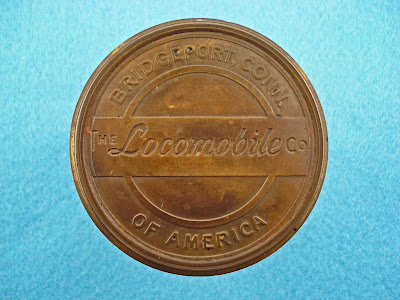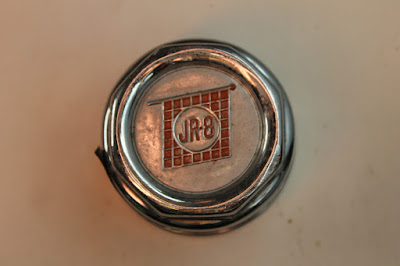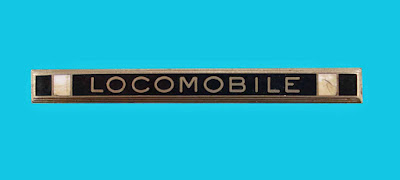Locomobile Company of America
Watertown, Massachusetts (1899-1900)
Bridgeport, Connecticut (1901-1929)
 |
| This is a Locomobile radiator emblem (1929) mjs Size: 53mm diameter MM: D L Auld |
In 1899, John Brisben Walker and Amzi Lorenzo Barber bought the Stanley Brothers steam car business (see Stanley) and produced steam cars in Watertown under the name Locomobile. The partnership broke up soon after. Walker moved to Tarrytown to build the same car but now called the Mobile and Barber remained in Watertown with the Locomobile name. In 1900, Barber secured a factory in Bridgeport, Connecticut and moved all Locomobile production there in 1901.
By May 1902, over 4,000 steam powered Locomobiles had been built. A gasoline Locomobile, designed in secret by Andrew Lawrence Riker (see Riker), was also built in 1902 and was introduced alongside Locomobile steamers in 1903. Steamers were discontinued in 1905.
The Riker-designed Locomobile gasoline car was an excellent but expensive automobile. In 1908, a 1906 Locomobile, called "Old 16", won the Vanderbilt Cup and Locomobile won other races in that year. In 1911, a six-cylinder T-head Locomobile was introduced as the Model 48 and this model would last as long as the Locomobile itself, with models in the late 1920's developing over 100 hp.
In 1914, Locomobile set up a special department to make customized models for wealthy clients. All seemed to be going very well but problems were to follow. A new management in 1915 planned a big expansion and purchased large quantities of materials on credit, but in 1919 these loans were called in during the postwar depression and there was no money to pay for them. Receivership followed.
In 1922, Emlen S. Hare bought Locomobile along with Mercer and Simplex to build a new motor car empire but this failed and Billy Durant took over in 1922. He kept the superb Model 48 but introduced a number of lower quality models, including the Locomobile Junior Eight in 1925. In 1929, the Model 88 was announced but the stock market crash brought an end to the Locomobile later in 1929.
Locomobile had also built commercial vehicles from 1901 until 1916. The first Locomobile commercial was a 1/2-ton steam delivery vehicle in 1901. By 1912, Locomobile introduced a 5-ton gasoline-powered truck and in 1915 a line of trucks was introduced, ranging from 3-ton to 6-ton capacity. In 1916, Locomobile trucks were renamed Riker (see Riker Truck).
Emblems
The Locomobile did not carry an emblem for many years but early vehicles did display the "Locomobile" name on small maker's nameplates and serial plates attached to the body of the vehicle, usually at the rear or under the driver's seat.
The "Locomobile" logo script appeared in the earliest Locomobile advertisements from 1899, see examples shown below:
 |
| This is a Locomobile ad showing logo script (1899) ms |
 |
| This is a Locomobile ad showing logo script (1899) ms |
The "Locomobile" logo script was also used on Locomobile maker's plates and serial plates, see examples shown below. Original early Locomobile serial plates and nameplates are rare.
 |
| This is a Locomobile serial plate (c1900) khc Size: 78mm wide 43mm high |
 |
| This is a Locomobile serial plate (1902) ms |
 |
| This is a Locomobile serial plate (1904) mjs Size: 83mm wide 50mm high |
 |
| This is a Locomobile nameplate (c1909) mjs Size: 80mm wide 29mm high |
The Locomobile name was also displayed on the hubcaps, see examples shown below, but first a hub emblem displaying an early Locomobile logo design:
 |
| This is an early Locomobile hub emblem (date unknown) mjs Size: 61mm diameter |
 |
| This is a Locomobile hub emblem (c1909) sam |
 |
| This is a Locomobile hub emblem (c1910) ms |
 |
| This is a Locomobile hub face (c1912) mjs Size: 72mm diameter |
The Locomobile owners were not particularly interested to display the "Locomobile" name prominently on their early cars, even when taking part in races or tours. The first use of a "Locomobile" radiator script appears to be in 1905, see original photo shown below, but other original photos taken at that time at public events, and for some years later, do not show a radiator script.
 |
| This is a Locomobile displaying a radiator script (1905) dpl |
Radiator scripts are commonly displayed on surviving Locomobile cars, see examples shown below, although many of these have been added later. Original Locomobile radiator scripts are rare.
 |
| This is a Locomobile showing radiator script (1908) ms |
 |
| This is a Locomobile radiator script (1914) conceptcarz |
 |
| This is a Locomobile radiator script (1927) rmsothebys |
The Locomobile Junior Eight model introduced in 1925 carried a small, black and white enamel rectangular radiator emblem, see example shown below. This was the first Locomobile radiator emblem and is very rare.
 |
| This is a Locomobile Junior radiator emblem (1925-1927) mjs Size: 76mm wide 9mm high MM: Unknown (poss D L Auld) |
The following photos show examples of Locomobile Junior Eight hub emblems:
 |
| This is a Locomobile Junior Eight hub emblem (1925-1927) mjs Size: 63mm diameter |
 |
| This is a Locomobile Junior Eight hub (1925-1927) dkc |
In 1928, the Model 48 carried a small rectangular Locomobile radiator emblem, similar to the Junior Eight emblem shown earlier, see example below:
 |
| This is a Locomobile Model 48 with a radiator emblem (1928) linkmotors |
The black and white enamel Locomobile radiator emblem is shown below. This Locomobile radiator emblem was also used on the Model 8-70. This Locomobile radiator emblem is very rare.
 |
| This is a Locomobile radiator emblem (1928) mjs Size: 76mm wide 9mm high MM: D L Auld |
There is another, similar white and black enamel Locomobile radiator emblem, see example shown below, probably around the same time as the previous emblems but I do not know which Locomobile models used this emblem, which is very rare.
 |
| This is a Locomobile radiator emblem (c1927-1928) mjs Size: 76mm wide 9mm high MM: Unknown (poss D L Auld) |
The 115 hp Model 88 introduced in 1929 was advertised as the "first Locomobile ever to wear a crest". This was the round, multi-colored enamel Locomobile radiator emblem bearing a shield shown above at the top of this post and again below. Very few were built before the Locomobile was finished later in 1929, making this another very rare Locomobile radiator emblem.


No comments:
Post a Comment